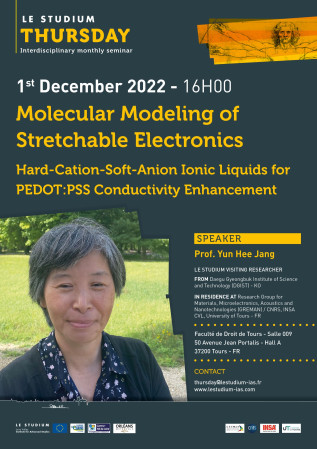Molecular Modeling of Stretchable Electronics
Hard-Cation-Soft-Anion Ionic Liquids for PEDOT:PSS Conductivity Enhancement
Faculté de Droit de Tours - Salle 009
50 Avenue Jean Portalis - Hall A
37200 Tours
France
Presentation
Materials are such an important aspect of civilization that our history is often defined by materials: stone, bronze, iron, and then polymers. What about now? No one would deny that we are in the silicon age. Since a transistor was invented in 1948, we are now surrounded by all kinds of electronic devices containing silicon-based semiconductors. A conjugated conducting polymer with alternating single and double bonds was discovered in 1977. The flexibility of such synthetic metals is a critical feature for realizing foldable phone, rollable TV, artificial skin, medical implant, and so on, and therefore organic electronics using such organic semiconductors slowly replace or complement the silicon electronics. Wearable devices like Apple Watch will soon become skin-like patch devices and even go inside our bodies to correct irregular heartbeats and improve our brain functions. We can say that we are now entering the renaissance of the (conducting) polymer age. A key player in such organic (bio)electronic devices is PEDOT:PSS. This water-processable (therefore environmentally-benign) polymer mixture of positively-charged PEDOT+ and negatively-charged PSS–receives great attention as a flexible and transparent organic semiconductor and electrochemical transistor, which can be used for applications such as organic LED, solar cell, thermoelectric genera-tor, and implantable sensor-actuator. However, PEDOT:PSS films form 10-to-30-nm granular domains, where conducting-but-hydrophobic PEDOT is surrounded by hydrophilic-but-insulating PSS, hindering formation of large conducting PEDOT networks. It makes PEDOT:PSS water-soluble and thermally stable, but very poor in conductivity. A tremendous amount of effort has been made to enhance its conductivity and recently we achieved remarkable up-to-5,000-fold improvements of conductivity by mixing PEDOT:PSS with proper ionic liquids (ILs).1 In a series of free energy calculations using density functional theory and molecular dynamics simulation,2-5 we demonstrated that the classic hard-soft acid-base (cation-anion) principle of chemistry plays a role in such improvements. Ion exchanges between PEDOT+:PSS– and A+:X– ILs help PEDOT+ to decouple from PSS– and to grow into large-scale conducting domains of π-stacked PEDOT+ decorated by IL anions X–, and therefore the most spontaneous decoupling between soft (hydrophobic) PEDOT+ and hard (hydrophilic) PSS– would be induced by strong interaction with soft anions X– and hard cations A+, respectively. Such principles led us to design new protic ILs and indeed they improved not only the conductivity but also the stretchability of PEDOT:PSS.6

Yun Hee Jang1,2 and Yves Lansac1,2,3
1 Department of Energy Science and Engineering, DGIST, Daegu 42988, Korea (yhjang@dgist.ac.kr)
2 GREMAN, CNRS UMR 7347, Université de Tours, 37200 Tours, France (lansac@univ-tours.fr)
3 LPS, CNRS UMR 8502, Université Paris-Saclay, 91405 Orsay, France
This work was supported by the National Research Foundation of Korea (2019R1A2C2003118 and 2021H1D3A2A01099453) and Le STUDIUM Loire Valley Institute for Advanced Studies.
[1] Kee, S. et al. Controlling Molecular Ordering in Aqueous Conducting Polymers Using Ionic Liquids, Adv. Mater. 2016, 28, 8625–8631.
[2] de Izarra, A.; Park, S.; Lee, J.; Lansac, Y.; Jang, Y. H. Ionic Liquid Designed for PEDOT:PSS Conductivity Enhancement, J. Am. Chem. Soc. 2018, 140, 5375–5384.
[3] de Izarra, A.; Choi, C.; Jang, Y. H.; Lansac, Y. Ionic Liquid for PEDOT:PSS Treatment. Ion Binding Free Energy in Water Revealing the Importance of Anion Hydrophobicity, J. Phys. Chem. B 2021, 125, 7, 1916–1923.
[4] de Izarra, A.; Choi, C.; Jang, Y. H.; Lansac, Y. Molecular Dynamics of PEDOT:PSS Treated with Ionic Liquids. Origin of Anion Dependence Leading to Cation Design Principles, J. Phys. Chem. B 2021, 125, 8601–8611.
[5] Choi, C.; de Izarra, A.; Han, I.; Jeon, W.; Lansac, Y.; Jang, Y. H. Hard-Cation-Soft-Anion Ionic Liquids for PEDOT:PSS Treatment, J. Phys. Chem. B, 2022, 126, 1615–1624.
[6] Kim, M. et al. Protic Ionic Liquids for Intrinsically Stretchable Conductive Polymers, ACS Appl. Mater. Interfaces (under revision).
Speaker
LE STUDIUM Visiting Researcher
FROM: Daegu Gyeongbuk Institute of Science and Technology (DGIST) - KO
IN RESIDENCE AT: Research Group for Materials, Microelectronics, Acoustics and Nanotechnologies (GREMAN) / CNRS, INSA CVL, University of Tours - FR

